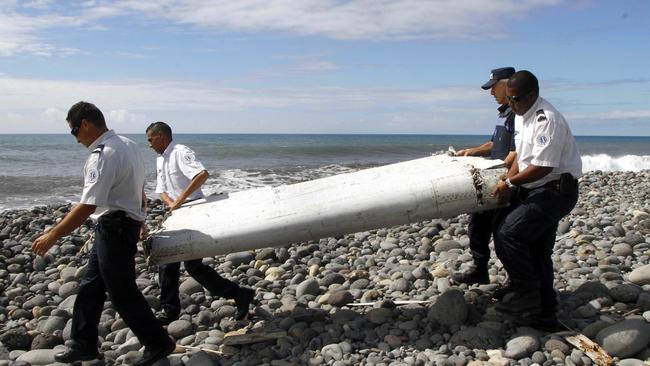New MH370 wreckage points to deliberate crash by jet’s pilot
A pilot on the lost flight MH370 lowered the doomed jet’s landing gear in the last seconds of flight, suggesting a possible criminal intent behind one of the world’s greatest aviation mysteries.

A pilot on the lost flight MH370 lowered the doomed jet’s landing gear in the last seconds of flight, suggesting a possible criminal intent behind one of the world’s greatest aviation mysteries.
Damage to a landing gear door from the Malaysia Airlines jet found in the possession of a Madagascan fisherman last month, is the first physical evidence to suggest one of the pilots deliberately acted to quickly destroy and sink the Boeing 777 with 239 people aboard.
Identified as a Boeing 777 landing gear component, the wreckage has most likely been penetrated from the inside by the aircraft’s disintegrating engines, making it highly probable the landing gear was down when the plane crashed into the southern Indian Ocean on March 8, 2014. The discovery of the trunnion door was not announced until Monday but has prompted calls for an urgent further investigation into the fate of the 12 Malaysian crew members and 227 passengers from 14 different nations who are presumed to have died.
The new analysis, by British engineer Richard Godfrey and Blaine Gibson, an American MH370 wreckage hunter, suggests the plane was crashed quickly and deliberately.
When airliners have to emergency land on water, pilots do not normally lower the undercarriage because the extended landing gear will dig into the water, disrupting contact with the surface and increasing the risk of violent break-up as the aircraft slows.
Pilots are trained to perform emergency landings with landing gear retracted for a controlled, low-speed ditching – as achieved by US captain Chesley “Sully” Sullenberger when he successfully landed his stricken Airbus on New York’s Hudson River in 2009.
The flaps on flight MH370 are thought not to have been retracted to slow the aircraft and extending the landing gear would have caused the immediate break up of the fuselage once the Boeing hit the Indian Ocean at high speed. Deploying the landing gear would also increase the chances of an airliner sinking quickly, limiting the time for any survivors to evacuate.
Pilots questioned the assumption that only a pilot could have extended the undercarriage. Part of the landing gear of an airliner could extend without human intervention if there was a structural failure in flight.
There has long been speculation over why the flight mysteriously reversed course and later vanished over the southern Indian Ocean after taking off from Kuala Lumpur on a less than seven-hour flight to Beijing.
The experienced pilot in command was Captain Zaharie Ahmad Shah, 53, from Penang, and his co-pilot Fariq Abdul Hamid, 27, who had joined Malaysia Airlines seven years earlier. Shah was married with three adult children, but some previous reports have suggested he may have suffered from clinical depression. Shah was known to have been disenchanted with Najib Razak, Malaysia’s prime minister at the time, calling him a “moron” in a social media post. Shah urged his followers: “There is a rebel in each and every one of us. Let it out!”
After MH370 disappeared a Malaysian police investigation discovered that he had used his home computer flight simulator to replicate a Boeing 777 flight south across the Indian Ocean less than a month before his plane vanished under uncannily similar circumstances. The revelation was withheld by Malaysia from a lengthy public report on the investigation.
Mr Gibson, a former lawyer who has recovered many of the 36 pieces of MH370 found around Indian Ocean shores, was handed the landing gear door last month in Madagascar by a fisherman named Tataly. Nineteen of the pieces of MH370 wreckage recovered so far have been found washed ashore in Madagascar and handed into the authorities.
The latest find is the damaged rectangular landing gear door, measuring 81cm x 71cm, which appears to match that used on Boeing 777 aircraft and is made of a carbon fibre reinforced plastic with a honeycomb – similar to other wing components that have been found to be from MH370.
The fisherman was unaware of the item’s significance. His wife had used it as a washing board since he found it on a beach close to his home in 2017, three years after MH370 disappeared.
There have long been two competing theories to explain why MH370 mysteriously reversed course and later vanished.
The first was a catastrophic event on board – such as a cockpit fire – that led to the incapacitation of the pilots and for the plane to fly uncommanded on auto-pilot before it ran out of fuel and crashed.
The second theory centred on a rogue pilot who deliberately caused the aircraft and all aboard to vanish. Under this theory, most suspicion falls on the flight’s captain, Shah, who it is claimed might have ordered his junior colleague to check something in the cabin, then locked him out of the cockpit, and possibly depressurised the aircraft, depriving others of oxygen.
A third underwater search for the aircraft on a “no find, no fee” basis has been mooted for next year by a US-based deep sea search firm, Ocean Infinity, but will require the Malaysian government to first agree to payment if the plane is found.
The Times



To join the conversation, please log in. Don't have an account? Register
Join the conversation, you are commenting as Logout